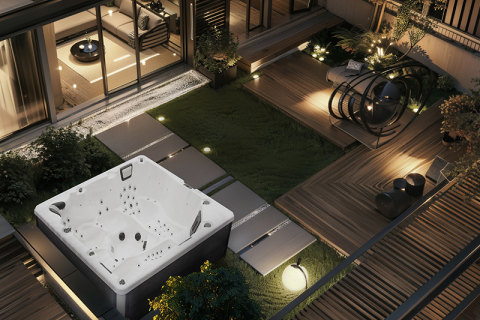
- Home
- >
News
After long-term use, whirlpool spa hot tubs are prone to accumulate scale and soap scum, causing the inner wall of the bathtub to become slippery and even discolored. Baking soda is a mild scrub that can easily wipe away scale without damaging the bathtub material.
Plug n play hot tub advantages: 1. Easy installation 2. Portability and flexibility 3. Low initial cost 4. Energy saving 5. Simple operation Disadvantages of plug n play hot tubs: 1. Slower heating speed 2. Weak hydromassage effect 3. Limited capacity 4. Limitations on heating and massage 5. Limited applicable environment
Two person outdoor hot tubs generally require at least 500 to 1000 kg of support force, because it is not only the weight of the tub itself, but also the weight of the heating system, water and the user. When choosing the installation location, first make sure that the balcony has a strong enough load-bearing capacity.
• A 300-gallon whirlpool hot tub weighs approximately 300 gallons × 8.34 pounds = 2,502 pounds (about 1,134 kilograms) when filled with water • A 600-gallon whirlpool hot tub weighs approximately 600 gallons × 8.34 pounds = 5,004 pounds (about 2,270 kilograms) • A 1,000-gallon whirlpool hot tub weighs approximately 1,000 gallons × 8.34 pounds = 8,340 pounds (about 3,785 kilograms) when filled with water
If the surface of the bath balls is too smooth or the design is unreasonable, they may be sucked into the spa hot tub filter under the push of the water flow, causing the filter to be blocked, thereby affecting the water purification function.
Generally speaking, the pump power range for small outdoor hot tubs is between 0.5 and 2 horsepower. The specific choice of pump power needs to be comprehensively considered based on the size of the bathtub, the number of massage nozzles, the intensity of the water flow, etc.
In many whirlpool hot tubs and spa equipment, "PR" generally refers to "Priming Mode", which is "drainage mode" or "starting mode". This is a special mode that the whirlpool hot tub automatically enters after the initial power-on or restart.
As a relatively fast-acting disinfectant, chlorine needs to be added frequently when used, while bromine has a relatively low maintenance frequency. Especially in terms of maintenance frequency and the application of automated equipment, bromine can provide outdoor spa hot tub users with an easier management experience.
The so-called jelly-like substance in the massage hot tub filter is usually called "biofilm". This sticky substance is a microbial aggregate, a gel-like structure formed by bacteria, fungi, algae and other microorganisms.
Regularly cleaning the interior of the outdoor garden hot tub, including removing grease, dirt and sediment, can effectively prevent water pollution. When cleaning, focus on cleaning the bathtub's nozzle, pipe system, filter and other parts to ensure that every detail is kept clean.
The water level of a round 2 person hot tub is usually set at 3/4 of the edge of the bathtub, that is, the height of the water surface from the edge of the bathtub is about 3/4 of the height of the bathtub.
The water pump is one of the core components of the whirlpool spa hot tub water flow system. If the water pump fails, it may cause the water flow to decrease. Common causes of pump failure include: ● Damage to the pump motor ● Wear of the pump's internal parts Pump power supply problem












